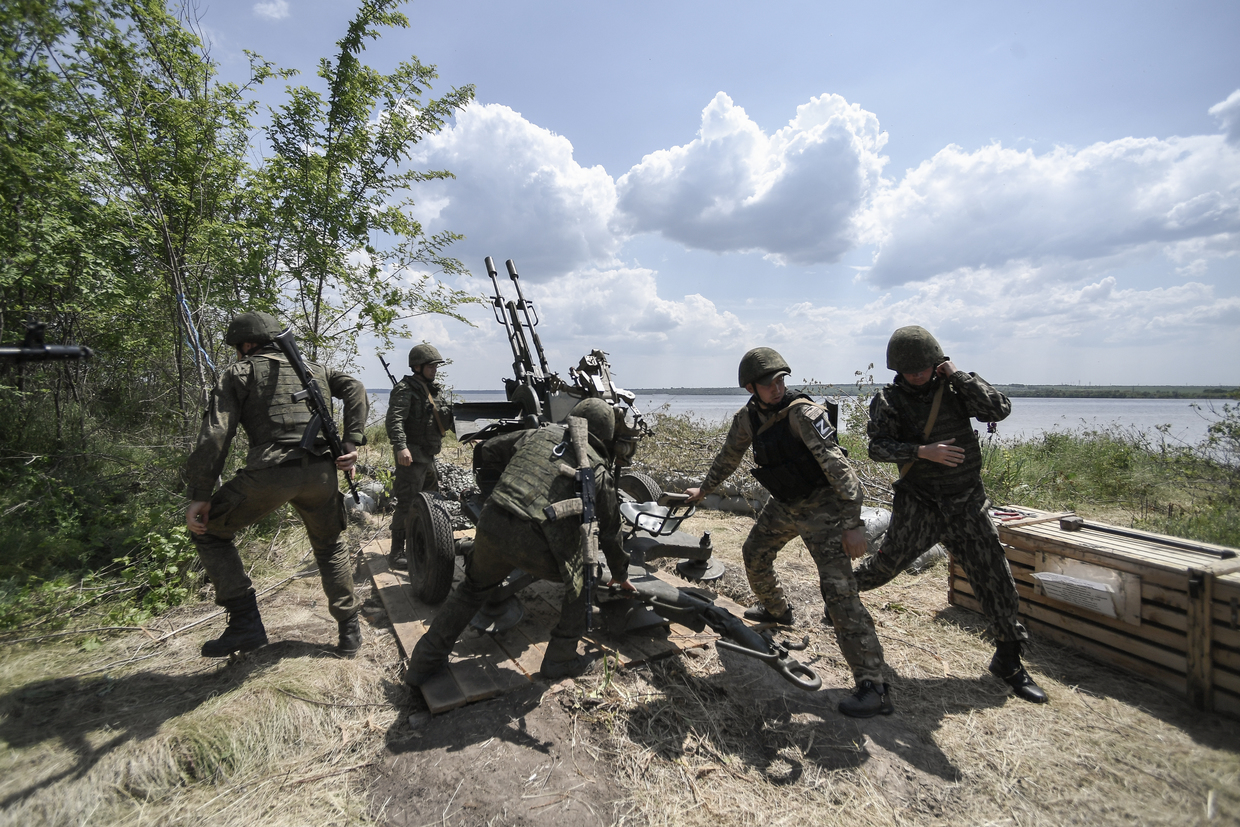
With neither side willing to pay the price for a full on assault, battles this summer are likely to stay local
Following the nine-month battle for Artyomovsk (Bakhmut), which is now in Moscow’s hands, the hostilities between Russia and Ukraine are set to enter a new stage. Although currently the front is experiencing a period of relative calm, this is not likely to last long as both sides will want to make the most of favorable summer conditions. Despite the losses suffered in Artyomovsk, both Moscow and Kiev want to earn a decisive victory over the enemy and avoid a prolonged war.

What developments can we expect at the front in the near future?
Strengths and weaknesses
Due to the superior operational capacity of Russia’s military-industrial complex, at current output levels, compared to that of NATO, a prolonged conflict may have some benefits for Russia. For example, in 2022, the United States produced only 14,000 155mm shells per month. Even as the US plans to increase production volumes (to 85,000 units per month by 2028), this is not enough to fully supply the Ukrainian army and also provide for the needs of the US army.
Meanwhile, Russia continues to rely on its superior firepower. Despite the shortage of ammunition that affected the units of the People’s Militias of the Lugansk and Donetsk People’s Republics in the fall of 2022, by May 2023 the country had produced enough shells to meet combat needs.
On the other hand, the Russian army is more sensitive to human losses due to political calculations – for example, President Vladimir Putin faces an election next year, should be decide to seek another term in the Kremlin – and clear hesitancy about putting the country on a full war footing. While Ukraine, which is under martial law, still has a large supply of military-aged men and is restrained only by its capacity to arm and train them, such measures are impossible for Russia because of the domestic political reality.
These factors make a prolonged war undesirable for both sides. In the next few years, Ukraine’s Western backers probably won’t be able to maintain the current levels of support – due to natural fatigue, election cycles and economic factors – and Moscow is seeking to avoid a second wave of mobilization. As a result, both sides are placing serious hopes on this summer.
The strategies of the two sides
An actionable strategy for Russia would be to conduct an operation similar to the Battle for Artyomovsk, forcing the Armed Forces of Ukraine (AFU) to fight within a limited area where Moscow could amass significant artillery power. This tactic would make it possible to neutralize the AFU’s presumed manpower advantage and weaken its forces, limiting its offensive potential.
Ukraine’s strength lies in the opposite strategy – using maneuverable groups to carry out strikes along the entire front line in order to exhaust Russian reserves, finding a weak spot in the defense, and attempting to break through. If successful, such actions could force Russian troops to retreat from strategically important territories, due to the risk of encirclement, as demonstrated during the battles in the Kharkov region in September 2022.
The role of aviation
Another important factor is the ongoing airwar. This past winter, the Russian Air Force was able to significantly damage Ukraine’s air defense, forcing NATO to provide Kiev with Western systems. In the spring, this operation continued and the Russian military claimed to have destroyed two Patriot missile systems. Despite the challenge of attacking Ukrainian air defense systems and the accompanying losses, the Russian Air Force was responsible for weakening Ukraine’s ability to mount an offensive by bombing warehouses as well as military and transport infrastructure. The Russian Air Force also prevented AFU brigades from being deployed for the offensive and weakened Kiev’s defense of Artyomovsk by striking the rear of its units from Slavyansk all the way to Dzerzhinsk.
Where will the battles take place this summer?
For Russia, which has retained its offensive capabilities, the summer campaign will likely resemble a series of local military operations. The AFU will mostly defend their positions and instead of introducing new units into battle, will try to wait for the exhaustion of Russian troops in order to counterattack.
Tension is expected in the following areas:
The “old” state border
After the retreat of Russia’s Armed Forces from the Chernigov, Sumy, and Kharkov regions, these territories were attacked by artillery fire and sabotage and reconnaissance groups (SRGs). Neither side has the power to form large assault groups and launch a direct offensive here. These battles could have stopped altogether, but the Ukrainians wanted to deal Russia a political and informational blow by making limited strikes on the Bryansk, Kursk, and Belgorod regions to create an image of Russian troop failures (and Ukrainian success).
Ukraine’s strategy here is to weaken Russian reserves. However, this strategy is flawed, since Russia can use its regular conscript army to defend its internationally recognized borders. For example, conscripts took part in repelling a recent Ukrainian raid carried out under the guise of Russian collaborationists (in reality a bunch of extreme neo-Nazis, who have found a welcome in Kiev, where their ideology is tolerated).
Despite Ukraine’s wish to make Russia concentrate its forces in this direction to the detriment of the Donbass and the Zaporozhye regions, the “old” state border is likely to remain a minor area of combat.
The Svatovo front
For Russia, positioning the front line along the border of the Oskol and Seversky Donets rivers would be quite desirable. Despite the difference in elevation (the west bank, where Ukraine’s army is positioned, is higher), the defense of this area would demand fewer forces since rivers act as natural barriers. Moreover, this would secure the important ring road around Valuyki –Svatovo–Severodonetsk.
Currently, battles in this area are taking place northeast of Kupyansk, where the Russian army has taken control of several villages in the past 4 months, and near the Kremensk Forests national park. In March of this year, the AFU repositioned several units from here to Artyomovsk, thereby reducing its defensive potential. Russia’s only reason for not attempting to advance further west towards Oskol may be its unwillingness to risk the small number of assault units stationed in this area.
The Seversky ledge
After the battles for Artyomovsk ended with a Russian victory, a layered situation has developed in this area. Firstly, Ukrainian troops are positioned near the city’s western border and rely on their fortifications along the Krasnoe-Minkovka line. This prevents the stabilization of the front along the presently defunct Seversky Donets-Donbass channel. And secondly, the so-called “Seversky ledge” hangs over the grouping’s northern flank.
As the Ukrainian counterattack on PMC Wagner in mid-May demonstrated, this location can be used to threaten Russian troops in Artyomovsk. Moreover, the Russian army also needs to capture Seversk in order to improve connections with troops further north.
The offensive potential of the Russian troops here is currently limited since PMC Wagner units, which fought in Artyomovsk, need a period of respite to restore their full fighting capacity. An offensive in this area can continue either after the Wagner Group fighters resume their work or after the transfer of other assault groups to this site. The presence of a significant concentration of AFU troops who survived the battle for Artyomovsk speaks in favor of continuing the offensive in this direction. If Kiev is able to stabilize this front, the AFU may transfer forces to other areas.
The Donetsk area
Battles for cities like Avdeevka and Maryinka have been raging since the beginning of the conflict. The Ukrainian defense here relies on urban infrastructure, which over the past eight years has been turned into an instrument of war. Because of this, the AFU managed to secure the front and drag the units of the Donetsk corps into exhausting positional warfare.
By the summer of 2023, Russian troops made positive progress in the area. They took complete control over the multi-storey buildings of Maryinka, were able to push the enemy about 10 kilometers away north of Avdeevka, and attack several roads leading into the city.
A shortage of ammunition and the low efficiency of avitation explains Russia’s problems in this direction. Recently, however, the units of the 1st corps received more munitions and the Russian Air Force has been provided with guided modules for aerial bombs.
Moving the front away from Donetsk – an important political and logistical center – is one of the main goals of the Russian army. This will lower the amount of strikes on this important city – and their subsequent political impact – as well as secure the army’s rear positions.
Ugledar
After the third assault on Ugledar failed because of Ukrainian minefields and an unsynchronized attack by Russian units, Moscow switched tactics and decided to destroy several blocks of multi-story buildings used by the AFU as firing and observation points.
Ugledar is strategically important because of the dominating height that stretches up to Kurakhovo. Ukraine’s defense southwest of Donetsk, including the southern flank of Maryinka, relies on Ugledar. Its capture would allow Russian troops to launch an offensive towards the Zaporozhye-Donetsk highway and assist the operations in Donetsk and Melitopol. The fourth assault on Ugledar should be expected after the Ukrainian positions in the area are suppressed by Russian aviation and artillery.
Melitopol
This is usually seen as a priority direction for a Ukrainian offensive. A breakthrough of the front near Tokmak and Pology followed by an advance to the Sea of Azov would be disastrous for Russia. The resulting isolation of Crimea from the rest of the country would make the peninsula a vulnerable target.
Over the past fall and winter, the Russian Armed Forces have reinforced this area, creating echelon formations with several fortress cities. This complicates any Ukrainian breakthrough. Moreover, even if the AFU had concentrated enough forces and succeeded in pushing forward, it would have faced flanking attacks by Russian units in reserve as well as air strikes with guided aerial bombs.
Still, the threat to Melitopol hasn’t been completely neutralized. Russia is still forced to amass forces in this area to be able to respond quickly to a potential AFU offensive. However, Ukraine missed an opportunity to completely defeat the enemy here.
The AFU is unlikely to launch a risky full-scale offensive in this direction. Instead, it will try to further weaken Russian forces in the area, making use of demonstrative attacks and local fighting in order to occupy the gray zone.
The front along the Dnieper River in the Kherson region
Currently, there are no active battles at this section of the front. The sides resort to occasional artillery fire and send sabotage and reconnaissance groups across the river. Neither side possesses sufficient resources for carrying out a major landing operation and supplying its troops in captured territory. Moreover, even if Ukraine, with its strategy of isolated local attacks, were to engage in such an operation, Russia holds the advantage here.
***
What do the above considerations leave us with? In one way or another, both sides will not be able to ignore the window of opportunity offered by favorable summer weather. We can expect renewed and more serious activity at the tension points of former battles. However, neither side will achieve a decisive victory this summer. They are only likely to secure more favorable positions for future combat. Thus, there’s no decisive end in sight.









